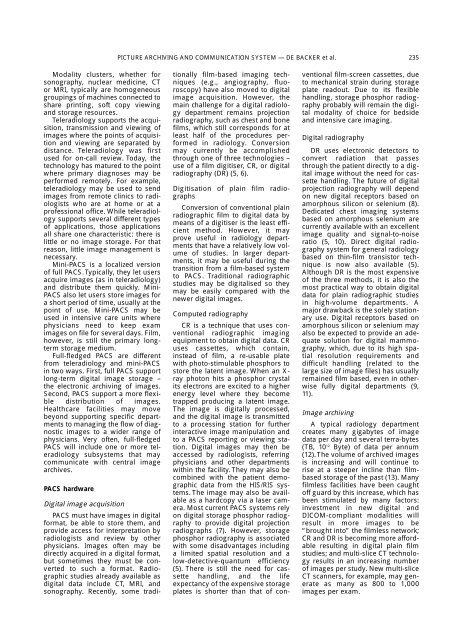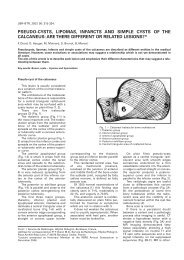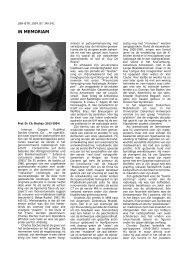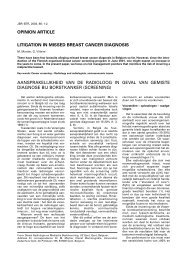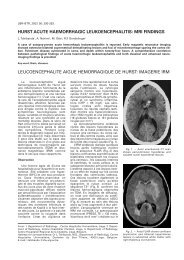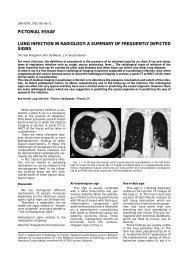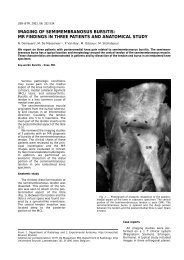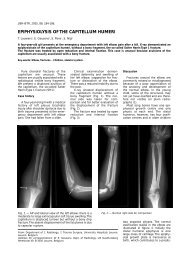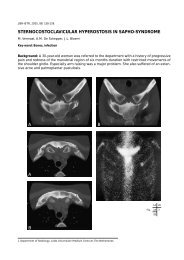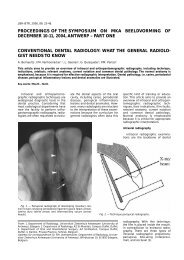review article picture archiving and communication system - rbrs
review article picture archiving and communication system - rbrs
review article picture archiving and communication system - rbrs
Create successful ePaper yourself
Turn your PDF publications into a flip-book with our unique Google optimized e-Paper software.
Modality clusters, whether for<br />
sonography, nuclear medicine, CT<br />
or MRI, typically are homogeneous<br />
groupings of machines connected to<br />
share printing, soft copy viewing<br />
<strong>and</strong> storage resources.<br />
Teleradiology supports the acquisition,<br />
transmission <strong>and</strong> viewing of<br />
images where the points of acquisition<br />
<strong>and</strong> viewing are separated by<br />
distance. Teleradiology was first<br />
used for on-call <strong>review</strong>. Today, the<br />
technology has matured to the point<br />
where primary diagnoses may be<br />
performed remotely. For example,<br />
teleradiology may be used to send<br />
images from remote clinics to radiologists<br />
who are at home or at a<br />
professional office. While teleradiology<br />
supports several different types<br />
of applications, those applications<br />
all share one characteristic: there is<br />
little or no image storage. For that<br />
reason, little image management is<br />
necessary.<br />
Mini-PACS is a localized version<br />
of full PACS. Typically, they let users<br />
acquire images (as in teleradiology)<br />
<strong>and</strong> distribute them quickly. Mini-<br />
PACS also let users store images for<br />
a short period of time, usually at the<br />
point of use. Mini-PACS may be<br />
used in intensive care units where<br />
physicians need to keep exam<br />
images on file for several days. Film,<br />
however, is still the primary longterm<br />
storage medium.<br />
Full-fledged PACS are different<br />
from teleradiology <strong>and</strong> mini-PACS<br />
in two ways. First, full PACS support<br />
long-term digital image storage –<br />
the electronic <strong>archiving</strong> of images.<br />
Second, PACS support a more flexible<br />
distribution of images.<br />
Healthcare facilities may move<br />
beyond supporting specific departments<br />
to managing the flow of diagnostic<br />
images to a wider range of<br />
physicians. Very often, full-fledged<br />
PACS will include one or more teleradiology<br />
sub<strong>system</strong>s that may<br />
communicate with central image<br />
archives.<br />
PACS hardware<br />
Digital image acquisition<br />
PACS must have images in digital<br />
format, be able to store them, <strong>and</strong><br />
provide access for interpretation by<br />
radiologists <strong>and</strong> <strong>review</strong> by other<br />
physicians. Images often may be<br />
directly acquired in a digital format,<br />
but sometimes they must be converted<br />
to such a format. Radiographic<br />
studies already available as<br />
digital data include CT, MRI, <strong>and</strong><br />
sonography. Recently, some tradi-<br />
PICTURE ARCHIVING AND COMMUNICATION SYSTEM — DE BACKER et al. 235<br />
tionally film-based imaging techniques<br />
(e.g., angiography, fluoroscopy)<br />
have also moved to digital<br />
image acquisition. However, the<br />
main challenge for a digital radiology<br />
department remains projection<br />
radiography, such as chest <strong>and</strong> bone<br />
films, which still corresponds for at<br />
least half of the procedures performed<br />
in radiology. Conversion<br />
may currently be accomplished<br />
through one of three technologies –<br />
use of a film digitiser, CR, or digital<br />
radiography (DR) (5, 6).<br />
Digitisation of plain film radiographs<br />
Conversion of conventional plain<br />
radiographic film to digital data by<br />
means of a digitiser is the least efficient<br />
method. However, it may<br />
prove useful in radiology departments<br />
that have a relatively low volume<br />
of studies. In larger departments,<br />
it may be useful during the<br />
transition from a film-based <strong>system</strong><br />
to PACS. Traditional radiographic<br />
studies may be digitalised so they<br />
may be easily compared with the<br />
newer digital images.<br />
Computed radiography<br />
CR is a technique that uses conventional<br />
radiographic imaging<br />
equipment to obtain digital data. CR<br />
uses cassettes, which contain,<br />
instead of film, a re-usable plate<br />
with photo-stimulable phosphors to<br />
store the latent image. When an Xray<br />
photon hits a phosphor crystal<br />
its electrons are excited to a higher<br />
energy level where they become<br />
trapped producing a latent image.<br />
The image is digitally processed,<br />
<strong>and</strong> the digital image is transmitted<br />
to a processing station for further<br />
interactive image manipulation <strong>and</strong><br />
to a PACS reporting or viewing station.<br />
Digital images may then be<br />
accessed by radiologists, referring<br />
physicians <strong>and</strong> other departments<br />
within the facility. They may also be<br />
combined with the patient demographic<br />
data from the HIS/RIS <strong>system</strong>s.<br />
The image may also be available<br />
as a hardcopy via a laser camera.<br />
Most current PACS <strong>system</strong>s rely<br />
on digital storage phosphor radiography<br />
to provide digital projection<br />
radiographs (7). However, storage<br />
phosphor radiography is associated<br />
with some disadvantages including<br />
a limited spatial resolution <strong>and</strong> a<br />
low-detective-quantum efficiency<br />
(5). There is still the need for cassette<br />
h<strong>and</strong>ling, <strong>and</strong> the life<br />
expectancy of the expensive storage<br />
plates is shorter than that of con-<br />
ventional film-screen cassettes, due<br />
to mechanical strain during storage<br />
plate readout. Due to its flexible<br />
h<strong>and</strong>ling, storage phosphor radiography<br />
probably will remain the digital<br />
modality of choice for bedside<br />
<strong>and</strong> intensive care imaging.<br />
Digital radiography<br />
DR uses electronic detectors to<br />
convert radiation that passes<br />
through the patient directly to a digital<br />
image without the need for cassette<br />
h<strong>and</strong>ling. The future of digital<br />
projection radiography will depend<br />
on new digital receptors based on<br />
amorphous silicon or selenium (8).<br />
Dedicated chest imaging <strong>system</strong>s<br />
based on amorphous selenium are<br />
currently available with an excellent<br />
image quality <strong>and</strong> signal-to-noise<br />
ratio (5, 10). Direct digital radiography<br />
<strong>system</strong> for general radiology<br />
based on thin-film transistor technique<br />
is now also available (5).<br />
Although DR is the most expensive<br />
of the three methods, it is also the<br />
most practical way to obtain digital<br />
data for plain radiographic studies<br />
in high-volume departments. A<br />
major drawback is the solely stationary<br />
use. Digital receptors based on<br />
amorphous silicon or selenium may<br />
also be expected to provide an adequate<br />
solution for digital mammography,<br />
which, due to its high spatial<br />
resolution requirements <strong>and</strong><br />
difficult h<strong>and</strong>ling (related to the<br />
large size of image files) has usually<br />
remained film based, even in otherwise<br />
fully digital departments (9,<br />
11).<br />
Image <strong>archiving</strong><br />
A typical radiology department<br />
creates many gigabytes of image<br />
data per day <strong>and</strong> several terra-bytes<br />
(TB, 1012 Byte) of data per annum<br />
(12). The volume of archived images<br />
is increasing <strong>and</strong> will continue to<br />
rise at a steeper incline than filmbased<br />
storage of the past (13). Many<br />
filmless facilities have been caught<br />
off guard by this increase, which has<br />
been stimulated by many factors:<br />
investment in new digital <strong>and</strong><br />
DICOM-compliant modalities will<br />
result in more images to be<br />
“brought into” the filmless network;<br />
CR <strong>and</strong> DR is becoming more affordable<br />
resulting in digital plain film<br />
studies; <strong>and</strong> multi-slice CT technology<br />
results in an increasing number<br />
of images per study. New multi-slice<br />
CT scanners, for example, may generate<br />
as many as 800 to 1,000<br />
images per exam.


